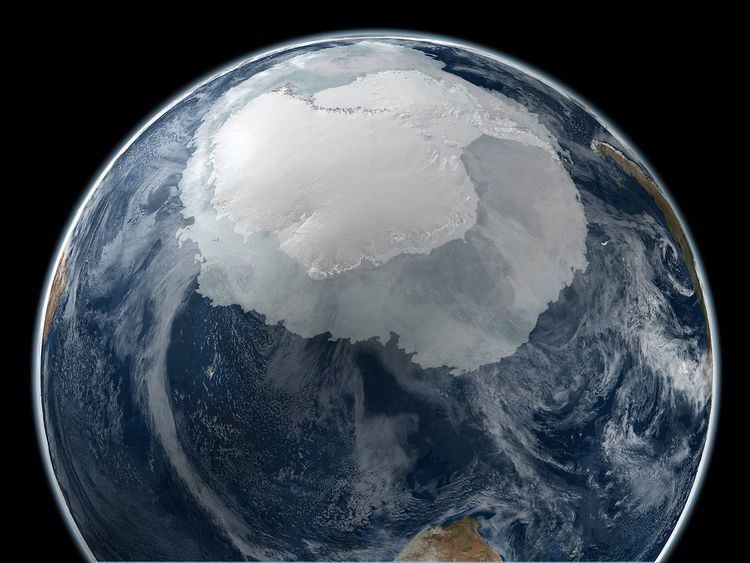 | ||
Antarctic sea ice is the sea ice of the Southern Ocean. It extends far north in winter and retreats almost to the coastline each summer. Sea ice freezes from seawater, and is usually less than a few meters thick. It should not be confused with the ice shelves, which are formed by glaciers flowing out into the sea and floating free of the bottom (these can be up to a kilometer thick). There are two subdivisions of sea ice: fast ice, which is attached to land; and ice floes, which are not.
Contents
Sea ice in the Southern Ocean is often snow-covered, and generally melts from below, unlike Arctic ice, so it rarely has meltponds on its surface. On average, Antarctic sea ice is younger, thinner, warmer, saltier, and more mobile than Arctic sea ice. Due to its inaccessibility, it is not as well-studied as Arctic ice.
Extent
The Antarctic sea ice cover is highly seasonal, with very little ice in the austral summer, expanding to an area roughly equal to that of Antarctica in winter. It peaks (~18 × 10^6 km^2) during September, which marks the end of austral winter, and retreats to a minimum (~3 × 10^6 km^2) in February. Consequently, most Antarctic sea ice is first year ice, a few meters thick, but the exact thickness is not known. The mass of 18 million km^2 of ice, for each meter of thickness, is 18,000 km^3 and roughly 16 gigatonnes (billion metric tons).
Since the ocean off the Antarctic coast is almost always much warmer than the air over it, the extent of the sea ice is largely controlled by the winds and currents that push it northwards. If it is pushed quickly, the ice can travel much further north before it melts. Most ice is formed along the coast, as the northward-moving ice leaves areas of open water (coastal latent heat polynyas), which rapidly freeze.
Thickness
Because Antarctic ice is mainly first-year ice, which is not as thick as multiyear ice, it is generally less than a few meters thick. Snowfall and flooding of the ice can thicken it substantially, and the layer structure of Antarctic ice is often quite complex.
Climate change
Recent changes in wind patterns around Antarctica have advected the sea ice farther north in some areas and not as far north in others (see images). The net change is a slight increase in the area of sea ice in the Antarctic seas (unlike the Arctic Ocean, which is showing a much stronger decrease in the area of sea ice). Increased sea ice extent does not indicate that the Southern Ocean is cooling, since the Southern Ocean is warming.
The IPCC AR5 report concluded that "it is very likely" that annual mean Antarctic sea ice extent increased 1.2 to 1.8% per decade, which is 0.13 to 0.20 million km2 per decade, during the period 1979 to 2012. The effect probably has more than one cause.
The IPCC fifth Assessment report (WG1) concluded that "Measurements of Antarctic sea ice thickness are too few to be able to judge whether its total volume (mass) is decreasing, steady, or increasing".
Implications for sub-surface temperatures and coastal currents have been identified, mainly related to changes in the southern hemispheric westerly winds, among possible implications is rapid Glacier melting, thus affecting calving rates and subsequently sea ice formation.
Temperatures in the atmosphere and Southern Ocean have increased during the period 1979–2004. However, sea ice grows faster than it melts, because of a weakly stratified Ocean. Thus, this mechanism is responsible for an increase in the net ice production, contributing to more sea ice. The sea ice volume increase presents about half the size of the increased freshwater supply from the Antarctic ice sheets. Modelling suggests that observed ice-drift toward the coastal regions are responsible for dynamical thickening during autumn and winter.
A study published in 2015 found that the subsurface ocean warming of ice-shelves increased freshwater runoff simulated by models, due to basal melt, and was responsible for an increase of sea ice in the winter months.
Effects on Navigation
The force of moving ice is considerable; it can crush ships that are caught in the ice pack, and severely limits the areas where ships can reach the land, even in summer. Icebreakers, iceports and ice piers are used to land supplies.
